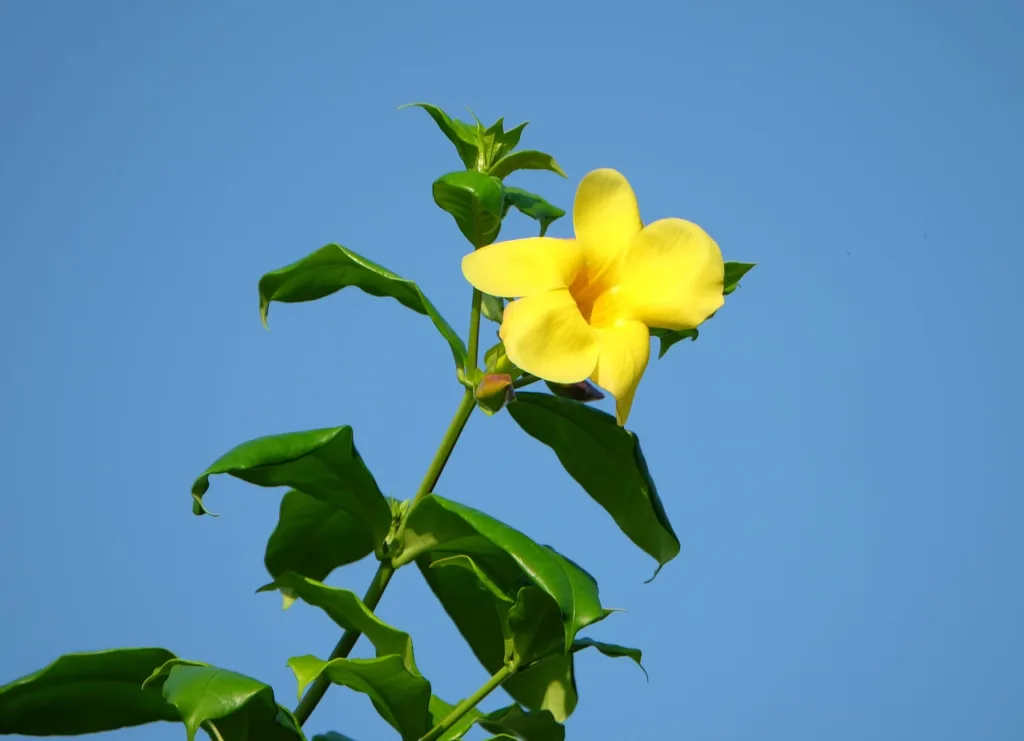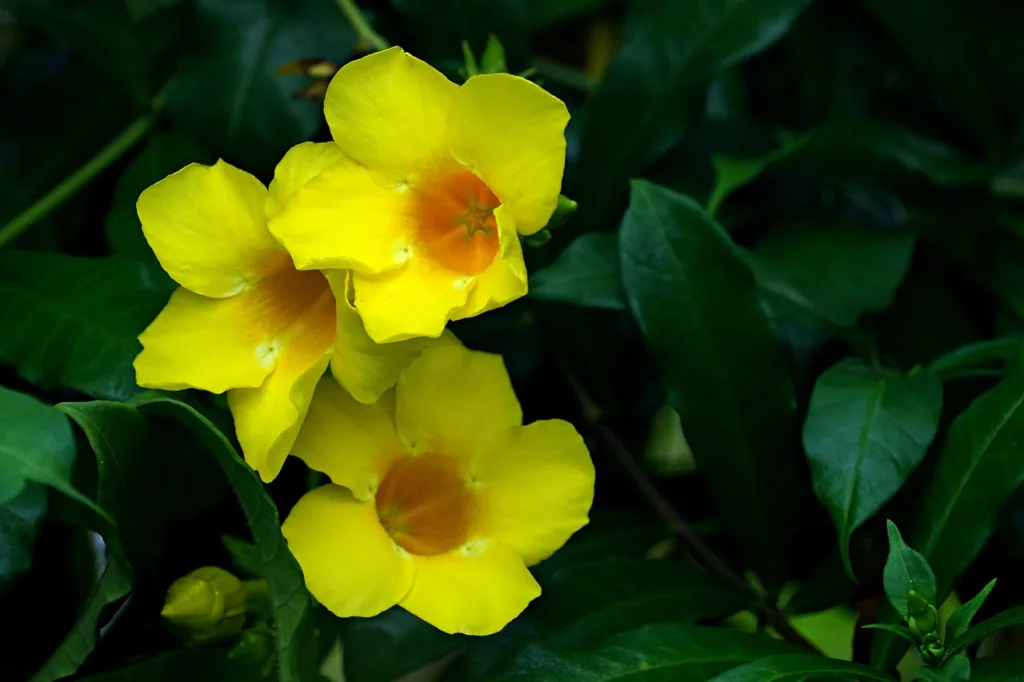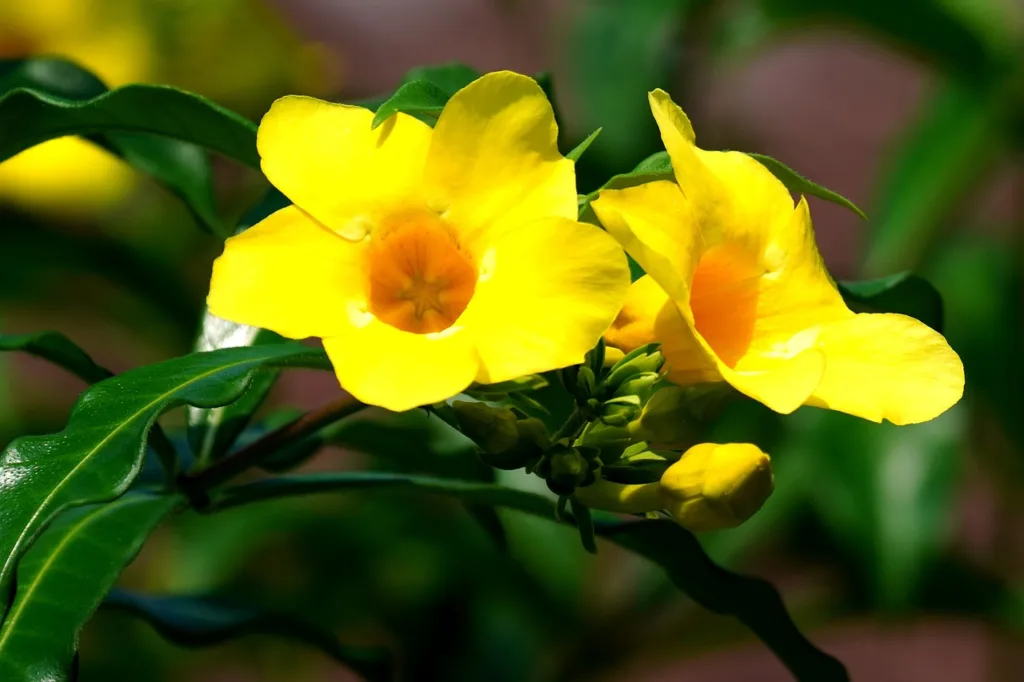Have you ever seen a vibrant and majestic flowering plant that instantly brightens up any space? Look no further than the beautiful Allamanda!
With its stunning yellow or purple trumpet-shaped blossoms, this tropical plant is sure to catch the eye and bring joy to any garden or indoor space.
In this article, we will explore everything you need to know about growing and caring for Allamanda, so you can enjoy its beauty all year round.
What is Allamanda
Allamanda is a genus of flowering plants in the dogbane family (Apocynaceae) known for its vibrant and showy trumpet-shaped flowers.
Native to tropical regions of the Americas, these evergreen shrubs or vines are cultivated for their ornamental value in gardens and landscapes.
The plants typically have glossy, lance-shaped leaves that complement the beauty of the flowers. The foliage is generally green, providing an attractive backdrop to the colorful blooms.
In tropical and subtropical regions, Allamanda is cultivated for its decorative value in gardens, parks, and along fences.
Due to its ability to cover structures with lush greenery and vibrant flowers, it is often used as an ornamental plant in landscaping.
The genus contains many species, with Allamanda cathartica being one of the most commonly cultivated species.
| It’s important to note that Allamanda plants contain milky sap that can be toxic if ingested, so caution should be exercised, especially in households with pets or small children. |
| Attribute | Information |
|---|---|
| Kingdom | Plantae |
| Division (Phylum) | Angiosperms (Flowering Plants) |
| Class | Eudicots |
| Order | Gentianales |
| Family | Apocynaceae |
| Genus | Allamanda |
| Species | Various species, including Allamanda cathartica |
| Common Name | Allamanda, Golden Trumpet, Yellow Bell |
| Native Range | Tropical regions of the Americas |
| Habitat | Tropical and subtropical climates, cultivated as ornamental plants |
| Characteristics | Showy trumpet-shaped flowers, glossy lance-shaped leaves, climbing or sprawling growth habit |
| Cultivation | Well-draining soil, full sun to partial shade, regular watering, pruning for size control |
| Toxicity | Contains toxic milky sap; caution advised in households with pets or small children |

Choosing the Right Location
Allamanda plants thrive in warm and sunny environments, making them perfect for tropical and subtropical regions.
When choosing a location for your allamanda, make sure it receives full sunlight for at least six hours a day.
This will help the plant produce abundant flowers and lush foliage. Additionally, ensure that the area has well-draining soil to prevent waterlogging, as excess water can lead to root rot.
Planting Allamanda
Now that you have found the perfect spot for your allamanda, it’s time to plant it. Here’s a step-by-step guide to help you get started:
- Dig a hole that is twice as wide and just as deep as the plant’s root ball.
- Gently remove the allamanda from its container and loosen the roots.
- Place the plant in the hole, ensuring that the crown is level with or slightly above the soil surface.
- Backfill the hole with soil, gently firming it around the plant.
Remember to water the newly planted allamanda thoroughly to settle the soil and help the roots establish themselves.
Watering and Moisture
Allamanda plants require consistent moisture to flourish. While they don’t appreciate being waterlogged, it’s important to keep the soil consistently moist, especially during dry spells.
During the growing season, which typically occurs in spring and summer, water your allamanda deeply once or twice a week. In cooler months, reduce the frequency but continue to monitor soil moisture.
To check whether your allamanda needs watering, simply insert your finger into the soil down to about an inch. If the top inch feels dry, it’s time to water.
Avoid over-watering, as this can lead to root rot and other issues. Proper watering will help your allamanda stay healthy and produce abundant blooms.
Fertilizing Allamanda
To encourage healthy growth and vibrant flowers, it’s important to fertilize your allamanda regularly. A balanced fertilizer with an NPK ratio of 10-10-10 or 15-15-15 is suitable for this plant.
Apply the fertilizer according to the manufacturer’s instructions, generally during the growing season. Avoid fertilizing during the dormant period in winter.
Additionally, a monthly application of organic compost or well-rotted manure can provide your allamanda with essential nutrients and improve soil fertility. This natural fertilizer will nourish the plant and support its overall health and vigor.

Pruning and Training
Pruning plays a crucial role in shaping and maintaining the appearance of your allamanda. You can prune your allamanda plant in late winter or early spring to remove dead or damaged branches. Additionally, trimming back the plant can help control its size and promote a bushier growth habit.
When pruning, make sure to use clean and sharp pruning shears to avoid injuring the plant. It’s also important to wear protective gloves, as allamanda sap can cause skin irritation in some individuals. Dispose of the pruned branches properly and clean your tools afterward to prevent the spread of diseases.
If you want to train your allamanda to climb a trellis or fence, gently tie the vines to the support structure using garden twine or soft plant ties. This will encourage the plant to grow upwards and create a stunning vertical display.
Common Pests and Diseases
While allamanda plants are generally resistant to pests and diseases, they can occasionally face some challenges. Here are a few common issues and how to tackle them:
- Aphids: These small insects can suck the sap from the plant and cause distorted growth. Use a strong stream of water to remove them or apply insecticidal soap if necessary.
- Whiteflies: These tiny, white insects can infest the leaves, leading to yellowing and a sticky residue. Use yellow sticky traps or apply neem oil to control their population.
- Leaf Spot: Fungal infections can cause dark spots on the leaves. Prune affected areas and a fungicide to prevent further spread.
Remember to regularly inspect your allam for signs of pests or diseases, as early detection can help prevent their escalation and your plant health.
Propagation Methods
If you want to expand your allamanda collection or share this beautiful plant with friends and family, there are a few propagation methods you can try:
- Seeds: Collect mature seeds from the plant and sow them in a well-draining potting mix. Keep the soil moist and maintain a warm temperature for successful germination.
- Cuttings: Take 4 to 6-inch stem cuttings from a healthy allamanda plant and remove the lower leaves. Dip the cut end in a rooting hormone and plant it in a pot filled with moist soil. Place the pot in a warm and bright location, and roots should form within a few weeks.
- Layering: Choose a low-growing branch and bend it down to touch the ground. Make a shallow cut on the underside of the branch and apply the rooting hormone. Cover the wounded area with soil and secure it with a rock or wire. Once roots develop, detach the new plant from the parent and transplant it into a separate pot or location.
Final Thoughts
Allamanda plants are a delightful addition to any garden or indoor space, bringing beauty and cheer with their vibrant blooms.
By following the tips and guidelines mentioned in this article, you can successfully grow and care for Allamanda.
Remember, patience and consistent care are key to helping this plant thrive. So go ahead, and let the allamanda’s charm brighten up your surroundings!
FAQs
Is Allamanda a Poisonous Plant?
Yes, Allamanda contains a toxic milky sap. Caution is advised, especially in households with pets or small children.
What is the Allamanda Plant in India?
Allamanda is a tropical and subtropical flowering plant cultivated for ornamental purposes in various regions of India.
What is the Common Name of Allamanda?
Commonly known as Allamanda, it is also referred to as Golden Trumpet or Yellow Bell due to its showy trumpet-shaped flowers.
Does Allamanda Need Full Sun?
Yes, Allamanda thrives in full sun to partial shade. It is recommended to provide it with ample sunlight for optimal growth and blooming.

